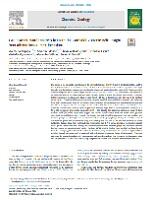Moune, Séverine
Person Preferred Name
Séverine Moune
Related Works
Content type
Digital Document
Abstract
The nature of the magmatic source beneath the Garibaldi Volcanic Belt (GVB) in NW Washington (USA) and SW British Columbia (Canada) has been debated both due to its classification as the northern equivalent of the High Cascades and the alkaline nature of northern basalts. Whole rock studies have shown that the GVB does not share the same magmatic source as the High Cascades (Mullen and Weis, 2013, 2015). Nonetheless, the presence of alkaline basalts in this arc raises questions about the exact source of mantle enrichment and whether it is related to the young age of the downgoing Juan de Fuca Plate (< 10 Ma) or the presence of a slab tear at the northern end of the arc. To gain insight into the source that underlies the GVB, we sampled olivine-hosted melt inclusions from each volcanic centre along the arc. Major, volatile and trace element data reveal a northward compositional trend from arc-typical calc-alkaline magma in the south to OIB-like melts in the north near the slab tear. Furthermore, contributions from the subducting slab are relatively high beneath the southern end of the arc (Cl/Nb> 80) but rapidly decreases to the north (Cl/Nb < 50). Finally, the significant differences in Zr/Nb from south to north (80 and 9, respectively) suggest two distinct mantle sources since one source cannot produce melts with such different ratios. As such, we propose the GVB should be segmented into the Northern and Southern groups, each having its own mantle source. Based on the geographic proximity, the enriched nature of the Northern group melt inclusions is likely controlled by the slab tear at the northern termination of the subducting Juan de Fuca Plate. Melt modelling results show that 3–7 % partial melting of the primitive mantle with a garnet lherzolite residue can reproduce the composition of the Northern group. Melt inclusions from the Southern group, on the other hand, imply a depleted MORB mantle that has been modified by fluids derived from the downgoing slab. Variability within the Southern group itself reflects the amount of hydrous fluids supplied beneath each centre and is correlated with slab age and subsequent degree of dehydration. This study addresses the compositional diversity along the arc and provides evidence that the age of the downgoing plate and the presence of a slab tear exert a strong compositional control over eruptive products within one arc.
Origin Information
Content type
Digital Document
Abstract
Las Sierras-Masaya volcanic system is a persistently active basaltic caldera complex in Nicaragua. While there has been almost no juvenile material erupted since 1772, Masaya volcano has been persistently degassing for >150 years. An additional unusual behaviour for the Las Sierras-Masaya volcanic complex is its ability to produce large caldera-forming basaltic Plinian eruptions with the most recent occurring about 1800 years ago.
Here we present melt inclusion analyses that provide constraints on the magmatic system over time. Melt inclusions hosted in plagioclase and olivine crystals were analyzed for major, trace and volatile elements (S, Cl, F, H2O). The data supports a consistent parental magmatic source with restricted compositional variability explained by simple fractional crystallization of plagioclase, olivine, clinopyroxene and magnetite at a nearly constant temperature. This broadly agrees with previous whole rock geochemical studies showing that the overall chemical signature of volcanic products at Masaya has remained largely unchanged for ~60,000 years and that both shallow fractionation and degassing processes dominate the whole evolution of the magmatic series. Based on volatile element in melt inclusions and gas composition and flux measurements, we determine the magmatic flux to be ~0.19 km3 yr−1 implying that up to 47 km3 of magma may have degassed since the last effusive eruption. As at other persistently active basaltic volcanoes (e.g., Mt. Etna, Italy; Kilauea, Hawaii, USA), this magmatic flux must involve significant endogenous storage which is likely accommodated by extensional tectonics. However, Masaya volcano differs in its apparent simplicity with respect to its stable chemistry and its fully interconnected magmatic system.
Origin Information


